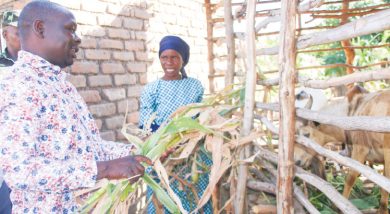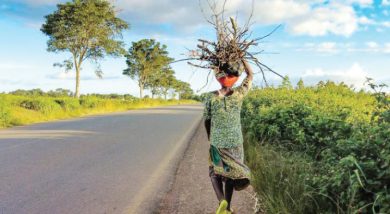No safe home in slums
Today, Mzuzu hosts the International Day for Disaster Reduction commemorations. Last year’s disaster in the city exposed gaps in ensuring everyone has a safe home. As JOHN CHIRWA and JAMES CHAVULA write, reducing exposure and displacement remains a promise broken.
On a sunlit Tuesday in May last year, two most powerful politicians in the country met on the hilltops of Masasa Township in Mzuzu.
The photograph of President Peter Mutharika and his deputy Saulos Chilima bears sharp resemblance to artist’s impressions of Moses and Joshua gazing at Canaan as Israelites walked free from bondage in Egypt.
But the politicians were not facing the Promised Land from their lofty perch.

Rather, Chilima was signalling his boss to the densely populated hills and valleys where six people perished, including Winston Mphande’s family which was buried in rubble as heavy rains and mudslides reduced homes to ruins on April 7 2016.
“We have to do something about this,” Mutharika whispered, pointing at a wreck where two children had died.
His No.2 nodded, urging against handouts likely to encourage the devastated population to cling to perilous slopes where “another devastating disaster would occur” unless they relocated.
Such was the shock and rhetoric when the disaster displaced almost 18 000 people in the ever-green city.
But Masasa is still home to an influx of Malawians escaping poverty in rural areas who often end up jobless, underemployed and destitute in slums.
For them, there is no safe home as the touted relocation has not taken off.
Mzuzu City chief executive officer Macleod Kadammanja blames the situation on land shortages.
Low-income earners have nowhere to settle as the council, Malawi Housing Corporation (MHC) and Department of Lands tussle over planned areas.
In the meantime, Consider Mwale and her neighbours can neither imagine nor afford life away from the slum.
“Masasa is my home,” says the mother of three, adding: “To relocate, I need to be given land and cash for a new home.”
In 2007, Mwale and her husband, a bricklayer, migrated from Traditional Authority (T/A) Kabunduli in Nkhata Bay.
They settled in the steep slopes when their hopes to get a decent job in the city were dashed.
“From building houses, we saved some money and bought this land at K12 000,” she says.
The Mwales know the area is a death trap, but they have nowhere to go and the city council has done little to enforce laws to safeguard citizens from settling in risky zones.
“This was the only area we could afford. We couldn’t buy land in city’s planned areas,” says Mwale.
The family personifies the dilemmas of many slum dwellers in the city where low-income earners are clustered in marshy townships of Chibanja, Chibavi, Salisbury Line, Ching’ambo, Chiputula, Zolozolo and Mchengautuba.
According to the council, there are 12 slums in the leafy city where over 60 percent of the population are living in places not fit for the purpose.
Urbanisation and widespread poverty has led to mushrooming of slums.
Siyani Mkandawire, a widowed mother of five, rents a K2 500-a-month, grass-thatched house in the waterlogged margins of Salisbury Line.
“I am stuck here because I cannot afford a home anywhere else,” she says.
The township suffers perennial floods as the city council keeps neglecting masses encroaching undesignated areas.
Physical planning expert Mtafu Zeleza Manda blames city authorities for not enforcing national guidelines on how to build resilient homes in risky wetlands.
“Although people live in these areas informally, they need to be protected. Houses need to have strong foundations and away from streams,” he says.
Social commentator Kolezi Phiri wants the council to end the problem of squatting.
“The council is not proactive and strategic. They usually react when disasters strike,” he says.
The April 7 humanitarian crisis jolted the council from its slumber.
Then, an emergency council meeting declared the city “a disaster zone” to mobilising resources for displaced citizens.
But this was too little, too late as urban disasters, the size that hit Blantyre, Zomba and Lilongwe in the past three years, are becoming chronic.
A study jointly conducted by Mzuni and the council led to the development of a disaster reduction strategy.
However, the blueprint was gathering dust, with no change on the ground, until the disaster struck.
Now, the council has adopted Mzuzu Disaster Recovery Framework to guide efforts to enhance the city’s disaster response, building resilience and reduce risks.
Mzuzu City mayor William Mkandawire is happy that the new strategy focuses more on preparing for recovery efforts before a disaster happens.
“The ability of a community to accelerate the recovery process begins with its efforts in pre-disaster preparedness, including risk mitigation, continuous planning, identifying resources and training them to effectively manage recovery through collaborative and inclusive processes,” he explains.
The pace and frequent disasters have prompted government to commemorate the International Day for Disaster Reduction in the city today.
Chilima will grace the observance, which promotes a culture of risk-awareness and celebrates how communities are reducing their exposure to disasters.
“The commemoration serves as a reminder to city dwellers in Mzuzu that they need to be prepared for such calamities,” says the mayor.
It will also acquaint Chilima, who heads the Department of Disaster Management Affairs, with first-hand information on gaps affecting the city for address. n





